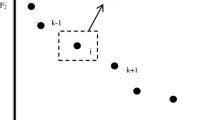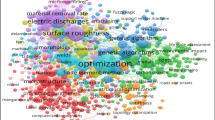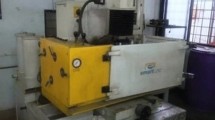Abstract
Silicon-wafer (Si-wafer) is a demandable semiconducting material for micro-fluidic application. Micro-channel on Si-wafer can be produced by electro-chemical discharge micro-machining process (µ-ECDM).Parametric effects on machining depth (MD), overcut (OC) and material removal rate (MRR) has been propounded using mixed electrolyte (NaOH and KOH) varying applied voltage(V), inter electrode gap(IEG)(mm),electrolyte concentration(wt%), pulse on time (µs) and duty ratio (%)during micro-channel cutting on Silicon-wafer using tungsten carbide(WC) cylindrical tool along with X-Y-Z axis movement by computer aided sub-system. ANOVA has been analysed to test adequacy of developed mathematical models and multi criteria parametric optimization and comparative analysis has been performed to interpretation maximum machining depth with higher material removal at lower overcut using desirability function analysis based on Response Surface Methodology (RSM), Genetic Algorithm (GA) and Particle swarm optimization (PSO).The SEM analysis has been made to find-out debris and to clear the micro-channel quality of Si-wafer. It is found that multi-response optimization parametric combinations are 50 V/55µs/31mm IEG/0.45 duty ratio/26.66wt% of NaOH and KOH mixed electrolyte. Particle swarm optimization (PSO) provides the best suitable convergence for the micro-machining of Silicon-wafer by ECDM process.
Similar content being viewed by others

Data Availability
The datasets generated during and/or analyzed during the current study are available with authors and would be provided to the journal if required.
References
Mallick B, Sarkar BR, Doloi B, Bhattacharyya B (2017) Analysis on electrochemical discharge machining during micro-channel cutting on glass. Int J of Precis Technol 7(1):32–50. https://doi.org/10.1504/IJPTECH.2017.10005511
Elhami S and M. R. Razfar (2017) Effect of ultrasonic vibration on the single discharge of electrochemical discharge machining. J Mater Manuf Process: 1-8. https://doi.org/10.1080/10426914.2017.1328113
Singh PK, Das AK, Hatui G, Nayak GC (2017) capacitor. Mater Chem Phys 198:16–34. https://doi.org/10.1016/j.matchemphys.2017.04.070
Elhami S, Razfar MR (2017) Analytical and experimental study on the integration of ultrasonically vibrated tool into the micro electro-chemical discharge drilling. Precis Eng 47:424–433. https://doi.org/10.1016/j.precisioneng.2016.09.015
Singh T, Dvivedi A (2017) On pressurized feeding approach for effective control on working gap in ECDM. Mater Manuf Process: 1-12. https://doi.org/10.1080/10426914.2017.1339319
Jin, Wang (2017) Li Sun and ZhixinJia,“Research on electrochemical discharge-assisted diamond wire cutting of insulating ceramics”Int. J Adv Manuf Technol. https://doi.org/10.1007/s00170-017-0751-x
Hajian M, Razfar MR, Etefagh AH (2017) Experimental study of tool bending force and feed rate in ECDM milling. Int J Adv Manuf Technol 91:1677–1687. https://doi.org/10.1007/s00170-016-9860-1
Tang W, Kang X, Zhao W (2017) Enhancement of electrochemical discharge machining accuracy and surface integrity using side-insulated tool electrode with diamond coating. Journal 27(6). https://doi.org/10.1088/1361-6439/aa6e94
Han M, Chae KW, Min BK (2017) Fabrication of high-aspect-ratio microgrooves using an electrochemical discharge micromilling process. Journal 27(5). https://doi.org/10.1088/1361-6439/aa64b9
Sarkar BR, Doloi B, Bhattacharyya B (2017) Experimental investigation into electrochemical discharge micro drilling on advanced ceramics. Int J Mater Form Mach Process 4(2):29 – 44. https://doi.org/10.4018/IJMFMP.2017070103
Sabahi N, Razfar MR (2018) Investigating the effect of mixed alkaline electrolyte (NaOH + KOH) on the improvement of machining efficiency in 2D electrochemical discharge machining (ECDM). Int J Adv Manuf Technol 95(1–4):643-657. https://doi.org/10.1007/s00170-017-1210-4
Yadav RN (2018) Electro-chemical spark machining– based hybrid machining processes:Research trends and opportunities. Proc Inst Mech E Part B J Eng Manuf: 1–25. https://doi.org/10.1177/0954405418755825
Tang W, Kang X, Zhao W (2019) Experimental investigation of gas evolution in electrochemical discharge machining process. Int J Electrochem Sci 14:970 – 984. https://doi.org/10.20964/2019.01.68
Oza AD, Kumar A, Badheka V, Arora A (2019) Traveling wire electrochemical discharge machining (TW-ECDM) of quartz using zinc coated brass wire: investigations on material removal rate and kerf width characteristics. Silicon: 1-12. https://doi.org/10.1007/s12633-019-0070-y
Madhavi JB, Hiremath SS (2019) Machining and characterization of channels and textures on quartz glass using µ-ECDM process. Silicon: 1-13. https://doi.org/10.1007/s12633-019-0083-6
Bellubbi S, NS, Mallick B (2021) Multi response optimization of ECDM process parameters for machining of microchannel in silica glass using Taguchi–GRA technique. Silicon. https://doi.org/10.1007/s12633-021-01167-4
Mallick B, Sarkar BR, Bhattacharyya B (2018) Analysis on the effect of ECDM process parameters during micro-machining of glass using genetic algorithm. J Mech Eng Sci 12(3):3942–3960
Mallick B, Biswas S, Sarkar BR, Doloi B, Bhattacharyya B (2019) On performances of electrochemical discharge micro-machining process using different electrolytes and tool shapes. Int J Manuf Mater Mech Eng (IJMMME) 10(2), Article-3. https://doi.org/10.4018/IJMMME.2020040103
Mallick B, Sarkar BR, Doloi B, Bhattacharyya B (2019) Modelling and analysis on performance of ECDM process for the fabrication of µ-channels on glass through response surface methodology. Manuf Technol Today (MTT) 18(9):39–51
Mallick B, Sarkar BR, Doloi B, Bhattacharyya B (2014) Multi criteria optimization of electrochemical discharge micro-machining process during micro-channel generation on glass. Appl Mech Mater 592–594:525–529
Mallick B, Hameed AS, Sarkar BR, Doloi B, Bhattacharyya B (2019) Experimental investigation for improvement of micro-machining performances of µ-ECDM process. Elsevier’s Materials Today
Dutta P, Majumder M, Kumar A (2021) Parametric optimization of liquid flow process by ANOVA optimized DE, PSO & GA algorithms. Int J Eng Manuf (IJEM) 11(5):14–24. https://doi.org/10.5815/ijem.2021.05.02
Antil P (2020) Modelling and multi-objective optimization during ECDM of silicon carbide reinforced epoxy composites. Silicon 12:275–288. https://doi.org/10.1007/s12633-019-00122-8
Paul L, Hiremath SS (2021) Model prediction and experimental study of material removal rate in micro ECDM process on borosilicate glass. Silicon https://doi.org/10.1007/s12633-021-00948-1
Singh T, Dvivedi A (2020) On prolongation of discharge regime during ECDM by titrated flow of electrolyte. Int J Adv Manuf Technol 107:1819–1834. https://doi.org/10.1007/s00170-020-05126-y
Rajput V, Goud M, Suri NM (2021) Three-dimensional finite element modeling and response surface based multi-response optimization during silica drilling with closed-loop ECDM. Silicon 13:3583–3609. https://doi.org/10.1007/s12633-020-00867-7
Dutta P, Kumar A (2020) Modelling of liquid flow control system using optimized genetic algorithm. Stat Optim Inf Comput 8(2):565–582. https://doi.org/10.19139/soic-2310-5070-618
Dutta P, Biswas SK, Biswas S, Majumder M (2021) Parametric optimization of solar parabolic collector using metaheuristic optimization. Comput Intell Mach Learn 2:7
Dutta P, Kumar A (2020) Modeling and optimization of a liquid flow process using an artificial neural network-based flower pollination algorithm. J Intell Syst 29(1):787–798
Dutta P, Kumar A (2018) Design an intelligent flow measurement technique by optimized fuzzy logic controller. J Eur Syst Autom 51(1–3):89
Bellubbi S, Naik R, Sathisha N (2021) An experimental study of process parameters on material removal rate in ECDM process. Mater Today Proc 35:298-302. https://doi.org/10.1016/j.matpr.2020.01.510
Bellubbi S, Hipparagi MA, Naik R, Sathisha N (2021) Optimization of process parameters in Electro Chemical Discharge Machining of silica glass through Analysis of Means. In: IOP Conference Series: Materials Science and Engineering, vol 1065, no 1. IOP Publishing, Bristol, p 012003. https://doi.org/10.1088/1757-899X/1065/1/012003
Acknowledgements
The authors are thankful to Yenepoya Institute of Technology, Moodabidri, Karnataka, India for permitting to conduct the experimentation work.
Funding
This work is self-financed and is not funded by any of the government/private/organizations.
Author information
Authors and Affiliations
Contributions
All the authors have equally contributed in terms of experimentation and writing of manuscript.
Corresponding author
Ethics declarations
Conflict of Interest
The authors do not have any conflicts of interest that may have a direct bearing on the subject matter of the article and it will not reflect any possible bias in either the exposition or the conclusions presented.
Compliance with ethical standards
This article does not contain any studies with human participants or animals performed by any of the authors.
Consent to Participate
The authors are free to contact any of the people involved in the research to seek further clarification and information. We understand that under freedom of information legalisation and entitled to access the information provided at any time while it is in storage as specified in the manuscript.
Consent for Publication
The authors give their consent for the publication of identifiable details, which can include photograph(s) and/or details within the manuscript to be published in Silicon Journal.
Additional information
Publisher’s Note
Springer Nature remains neutral with regard to jurisdictional claims in published maps and institutional affiliations.
Rights and permissions
About this article
Cite this article
Naik, R., Sathisha, N. Desirability Function and GA-PSO Based Optimization of Electrochemical Discharge Micro-Machining Performances During Micro-channeling on Silicon-wafer Using Mixed Electrolyte. Silicon 14, 10007–10021 (2022). https://doi.org/10.1007/s12633-022-01697-5
Received:
Accepted:
Published:
Issue Date:
DOI: https://doi.org/10.1007/s12633-022-01697-5



